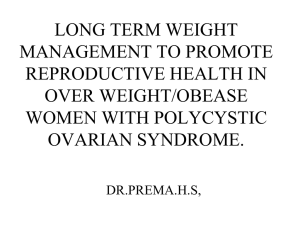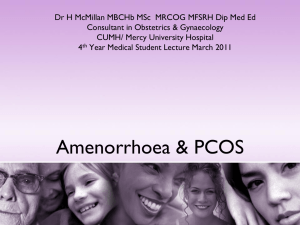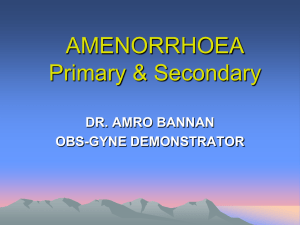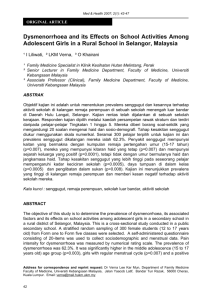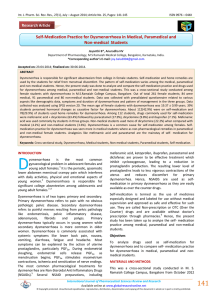Archana Kumari
advertisement
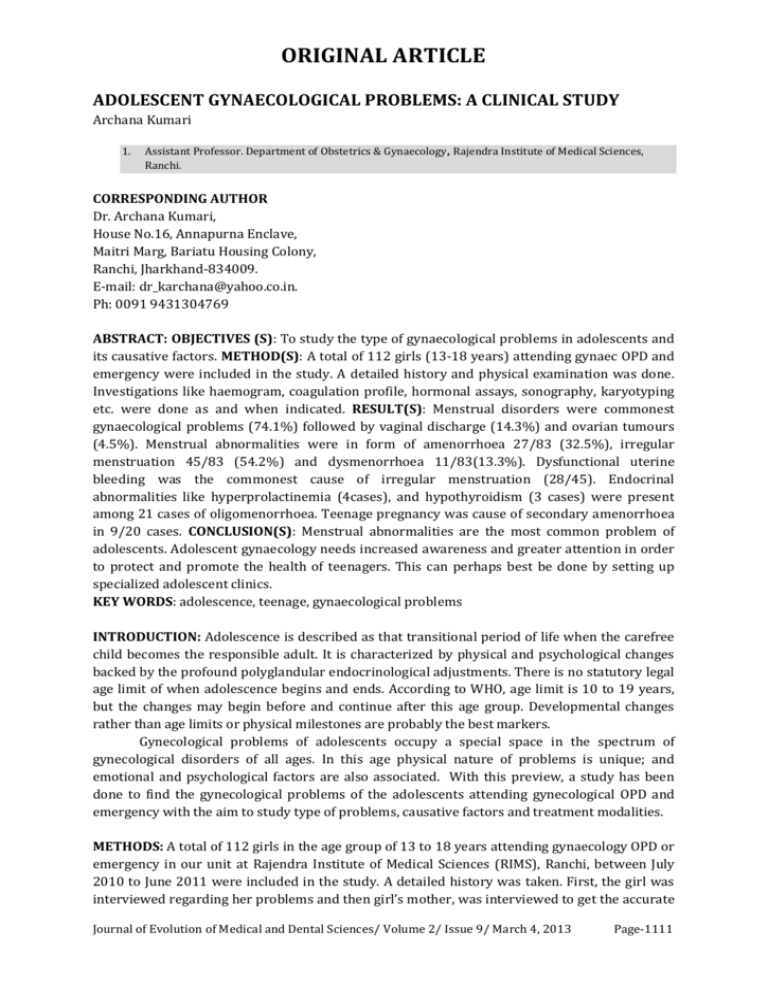
ORIGINAL ARTICLE ADOLESCENT GYNAECOLOGICAL PROBLEMS: A CLINICAL STUDY Archana Kumari 1. Assistant Professor. Department of Obstetrics & Gynaecology, Rajendra Institute of Medical Sciences, Ranchi. CORRESPONDING AUTHOR Dr. Archana Kumari, House No.16, Annapurna Enclave, Maitri Marg, Bariatu Housing Colony, Ranchi, Jharkhand-834009. E-mail: dr_karchana@yahoo.co.in. Ph: 0091 9431304769 ABSTRACT: OBJECTIVES (S): To study the type of gynaecological problems in adolescents and its causative factors. METHOD(S): A total of 112 girls (13-18 years) attending gynaec OPD and emergency were included in the study. A detailed history and physical examination was done. Investigations like haemogram, coagulation profile, hormonal assays, sonography, karyotyping etc. were done as and when indicated. RESULT(S): Menstrual disorders were commonest gynaecological problems (74.1%) followed by vaginal discharge (14.3%) and ovarian tumours (4.5%). Menstrual abnormalities were in form of amenorrhoea 27/83 (32.5%), irregular menstruation 45/83 (54.2%) and dysmenorrhoea 11/83(13.3%). Dysfunctional uterine bleeding was the commonest cause of irregular menstruation (28/45). Endocrinal abnormalities like hyperprolactinemia (4cases), and hypothyroidism (3 cases) were present among 21 cases of oligomenorrhoea. Teenage pregnancy was cause of secondary amenorrhoea in 9/20 cases. CONCLUSION(S): Menstrual abnormalities are the most common problem of adolescents. Adolescent gynaecology needs increased awareness and greater attention in order to protect and promote the health of teenagers. This can perhaps best be done by setting up specialized adolescent clinics. KEY WORDS: adolescence, teenage, gynaecological problems INTRODUCTION: Adolescence is described as that transitional period of life when the carefree child becomes the responsible adult. It is characterized by physical and psychological changes backed by the profound polyglandular endocrinological adjustments. There is no statutory legal age limit of when adolescence begins and ends. According to WHO, age limit is 10 to 19 years, but the changes may begin before and continue after this age group. Developmental changes rather than age limits or physical milestones are probably the best markers. Gynecological problems of adolescents occupy a special space in the spectrum of gynecological disorders of all ages. In this age physical nature of problems is unique; and emotional and psychological factors are also associated. With this preview, a study has been done to find the gynecological problems of the adolescents attending gynecological OPD and emergency with the aim to study type of problems, causative factors and treatment modalities. METHODS: A total of 112 girls in the age group of 13 to 18 years attending gynaecology OPD or emergency in our unit at Rajendra Institute of Medical Sciences (RIMS), Ranchi, between July 2010 to June 2011 were included in the study. A detailed history was taken. First, the girl was interviewed regarding her problems and then girl’s mother, was interviewed to get the accurate Journal of Evolution of Medical and Dental Sciences/ Volume 2/ Issue 9/ March 4, 2013 Page-1111 ORIGINAL ARTICLE details of any previous medical problems. Physical examination including height and weight, general examination, secondary sexual characters, and any congenital anomalies was noted. At the end of examination, nature of problem was discussed with the girl and parent. Privacy, comfort and friendliness were provided to the patient for getting any confidential information and sexual activity. Investigation such as haemogram, coagulogram, hormonal assays (FSH, LH, Prolactin, and Thyroid profile), ultrasound examination of abdomen and pelvis, karyotyping was done as and when indicated. RESULTS: Table 1 shows the broad classification of gynaecological problems observed in adolescent population under study. Menstrual disorders were the commonest problem (74.1%) followed by vaginal discharge (14.3%). Table 2 shows that the Menstrual abnormalities were in form of amenorrhoea 27/83 (32.5%), irregular menstruation 45/83 (54.2%) and dysmenorrhoea 11/83(13.3%). Menorrhagia was present in 15 subjects with three of them having Hb <5gm/dl, nine had 68gm/dl and three had >8gm/dl. Table 3 shows the aetiology of Amenorrhoea. Out of 7 cases of primary amenorrhoea, 2 had imperforate hymen, 4 had Mullerian agenesis and 1 had Turner’s syndrome. Among 14 cases of secondary amenorrhoea 10 had PCOS, 9 had pregnancy and 1 had premature ovarian failure. Table 4 shows causes of menstrual dysfunction. DUB defined as uterine bleeding in the absence of detectable pevic pathology was the commonest cause (28/45). DISCUSSION: Disturbances of menstruation, either actual or perceived, are the commonest presenting complaint in adolescent gynaecology clinic (75% of the new patients)1. The present study also shows menstrual disorders as commonest adolescent gynaecological problem (74%). These ranged from amenorrhea to menorrhagia. In present study, primary amenorrhoea accounted for 6.25%(7/112)of cases, which is similar to that reported by Sebanti et al2 (6.45%).Mullerian agenesis was found in four out of seven cases of primary amenorrhoea of which one also had solitary kidney. Three cases underwent vaginoplasty; in one case vaginoplasty was deferred till she was ready for marriage. Two cases of primary amenorrhoea presented with cyclic abdomen pain, retention of urine and hematocolpos (imperforate hymen) and were treated with cruciate incision of hymen.One case was diagnosed as Turner syndrome. Secondary amenorrhoea due to teenage pregnancy accounted for 8.03% (9/112) cases in our study. This is higher than that reported by Sebanti et al2(4.30%) All presented between 10-16 weeks. MTP was done in these subjects. The problem of preventing unwanted pregnancies needs to be urgently addressed3,4as it predisposes them to STIs, and RTIs (septic abortion and PID) affecting future reproductive health. PCOS based on clinical criteria of menstrual problem, features of hyperandrogenism and USG finding of multiple ovarian cysts was diagnosed in 10/20 cases of secondary amenorrhoea. There were 9 more cases of PCOS, who had presented with oligomenorrhoea. Thus PCOS was cause of irregular menses in 19/83 (22.9%) of cases in our study. Venturoli et al 5reports PCOS to be cause of irregular menses in one third (33%) of adolescent girls. Cycle regularity was restored with combined oral contraceptive pills. Addition of cyproterone acetate was helpful in presence of hirsutism. Journal of Evolution of Medical and Dental Sciences/ Volume 2/ Issue 9/ March 4, 2013 Page-1112 ORIGINAL ARTICLE Premature ovarian failure as a cause of secondary amenorrhoea is found in 10% cases below the age of 40.6It is rare in adolescents. In our study ,one girl had premature ovarian failure, diagnosis made on basis of amenorrhoea of one year after having regular periods for 2 years, serum FSH of 64IU/L and absence of follicle in the ovary on USG. The girl and her mother were counselled regarding future possibility of oocyte donation and pregnancy. Dysfunctional uterine bleeding (anovulatory type) is common in adolescents.7 In as many as 95% , abnormal vaginal bleeding is caused by DUB.8It is because of immaturity of HPO axis which may take 2 to 5 years for complete mauration.9 In present study 60.2% (28/45) cases of menstrual irregularities were found to have DUB. Counselling was done in the absence of menorrhagia. Hickey and Balen10 also mentions that reassurance of the girls and her parents is the most appropriate management of DUB. Anaemic subjects were treated with haematinics, antifibriolytics and hormones (OCPs or progestogens). Prolonged hormonal therapy with OCP was avoided as it causes premature fusion of epiphysis. In cases presenting with oligo-menorrhoea, hormonal assay (thyroid function tests and serum prolactin) yielded results in 7 out of 21 cases (1/3rd of cases), 4 had hyperprolactinemia and 3 had hypothyroidism. Hormonal assay should be a part of diagnostic work up of adolescents with menstrual disorders.10 Primary dysmenorrhoea was presenting complaint in 10 cases. Three cases had problem severe enough to prevent them from going to school. Their sibling and mother also had similar problems. Dickens11also mentions family history of Primary dysmenorrhoea. Endometriosis was diagnosed by ultrasound in one case of secondary dysmenorrhoea which was treated by removal of endometriotic cyst at laparotomy. Vaginal discharge was second commonest complaints in16/112 (14.23%) cases. All of them had physiological leucorrhoea which responded to counselling and maintenance of hygiene. STIs (Chlamydia, Human papilloma virus and herpes simplex virus infection) is reported in 8 to 27% of adolescent girls in western countries.12 Therefore, gynaecologists should have a high index of suspicion of STIs in this age group. Ovarian tumours were found in 5/112 cases (4.5%), 3 had simple serous cyst and 2 had dermoid cysts. Sebanti et al2 have reported higher incidence of ovarian tumour (15.32%) in their series. Four cases presented with injury to perineum, two were traumatic due to fall, and other two were due to sexual assault. STI and HIV screening was done in these cases as well as emergency contraception were prescribed. One case of labia majora abscess secondary to shaving of pubic hair required incision and drainage and antibiotics. Three unmarried girls presented with septic abortion due to illegal interference. One required laparotomy for generalised peritonitis. One was admitted in a state of septic shock with ARF and died within few hours of admission. One case of incomplete septic abortion with features of local peritonitis was managed with antibiotics and D&E. In all cases, corrective measures and counselling of the girl and family was done. WHO estimates that 2.5 million adolescents have unsafe abortions annually.13 It is a complex and challenging issue. We need to create awareness about negative health consequences and socio-economic causes. CONCLUSION: Teenage problems need to be dealt with sensitively. Counselling is an integral component of treatment strategies. Safe sex practices, STIs specially HIV and emergency contraception should be included in sex education. At present, adolescent gynaecology remains an area to which increased awareness and greater attention should be given to protect and Journal of Evolution of Medical and Dental Sciences/ Volume 2/ Issue 9/ March 4, 2013 Page-1113 ORIGINAL ARTICLE promote the health of teenagers. This can perhaps best be done by setting up specialized “Adolescent Gynaecological Clinics”. REFERENCES: 1. O. Sheil, M. Turner. Adolescent Gynaecology. Progress in Obstetrics and Gynaecology; 12:215-233 2. Goswami Sebanti et al. A Profile of Adolescent girls with Gynaecological Problems. J Obstet Gynecol India 2005; 55(4):353-355 3. Mellenby A, Phelps F, Tripp JH. Teenagers, Sex and Risk Taking. Br Med J 1993;307:25 4. Smith T. Influence of socio economic factors on attaining targets for reducing teenage pregnacies. Br Med J 1993; 306:1232-1235 5. Venturoli S, Porcu E, Fabbri F, Paradisi R,Ruggeri, Boleli S, Orsini F, Gabbi D, Flanigni C L, menstrual irregularities in adolescents : hormonal pattern and ovarian morphology. Horm. Res ,1987;24:269-279 6. Coulam CB, Adamson SC, Annegers JP. Incidence of Premature Ovarian Failure. Obstet Gynecol1986;67:604-6 7. Sanifelepo J, Yussman M. Gynaecological problems of Adolescence. In:Lavery J, Sanifelepo J. (eds). Pediatric and Adolescent Gynaecology New York Springer-Verlag, 1985;61-3 8. Deligeoroglou E. Dysfunctional Uterine Bleeding. Ann NY Acad Sci 1997;816:158-64. 9. Falcone T, Desjardins C, Bourque J et al. Dysfunctional Uterine Bleeding in Adolescents. J Reprod Med 1994;39:7761-4 10. Martha Hickey ,Adam Balen.Menstrual disorders in adolescence: Investigation and Management.Human reprodution update 2003;9(5): 493-504 11. Dickens A. Excessive Menstrual Bleeding and Dysmenorrhoea. Clin Obstet Gynaecol 1974; 17:665-659 12. Berry PL, Schubiner H, Giblin PT. Issues in Adolescent Gynaecological Care. Obstet Gynaecol Clin N Am 1990; 17(4):837-849 13. IPAS. Adolescents,unwanted pregnancyand abortion 1-49 Table-1: GYNAECOLOGICAL PROBLEMS Types Menstrual disorder Vaginal discharge Ovarian tumours Traumatic injury to perineum Labia Majora abscess Septic abortion Sexual assault Number 83 16 5 2 1 3 2 Percent 74.1% 14.3% 4.5% 1.8% 0.9% 2.7% 1.8% Journal of Evolution of Medical and Dental Sciences/ Volume 2/ Issue 9/ March 4, 2013 Page-1114 ORIGINAL ARTICLE Table-2: TYPE OF MENSTRUAL DISORDERS (n=83) Type of Menstrual Disorder Amenorrhoea Primary Secondary Menstrual Dysfunctions Dysmenorrhoea Primary Secondary Irregular Menses Polymenorrhoea Oligomenorrhoea Menorrhagia Table-3: Causes of Amenorrhoea (n=27) Causes Primary Amenorrhoea 7 Imperforate Hymen Mullerian agenesis Turner’s syndrome Secondary Amenorrhoea 20 Polycystic ovarian disease Pregnancy Premature ovarian failure Table-4: Causes of Menstrual Dysfunctional (n=56) Types of Menstrual Disorder Dysmenorrhoea Primary Secondary Irregular Menses Dysfunctional uterine bleeding Polycystic ovarian syndrome Hypothyroidism Hyperprolactinemia Clotting disorder (ITP) Number 27 (32.5%) 7 20 11 (13.3%) 10 1 45 (54.2%) 9 21 15 Number 2 4 1 10 9 1 Number 11 10 1 45 28 9 3 4 1 Journal of Evolution of Medical and Dental Sciences/ Volume 2/ Issue 9/ March 4, 2013 Page-1115


